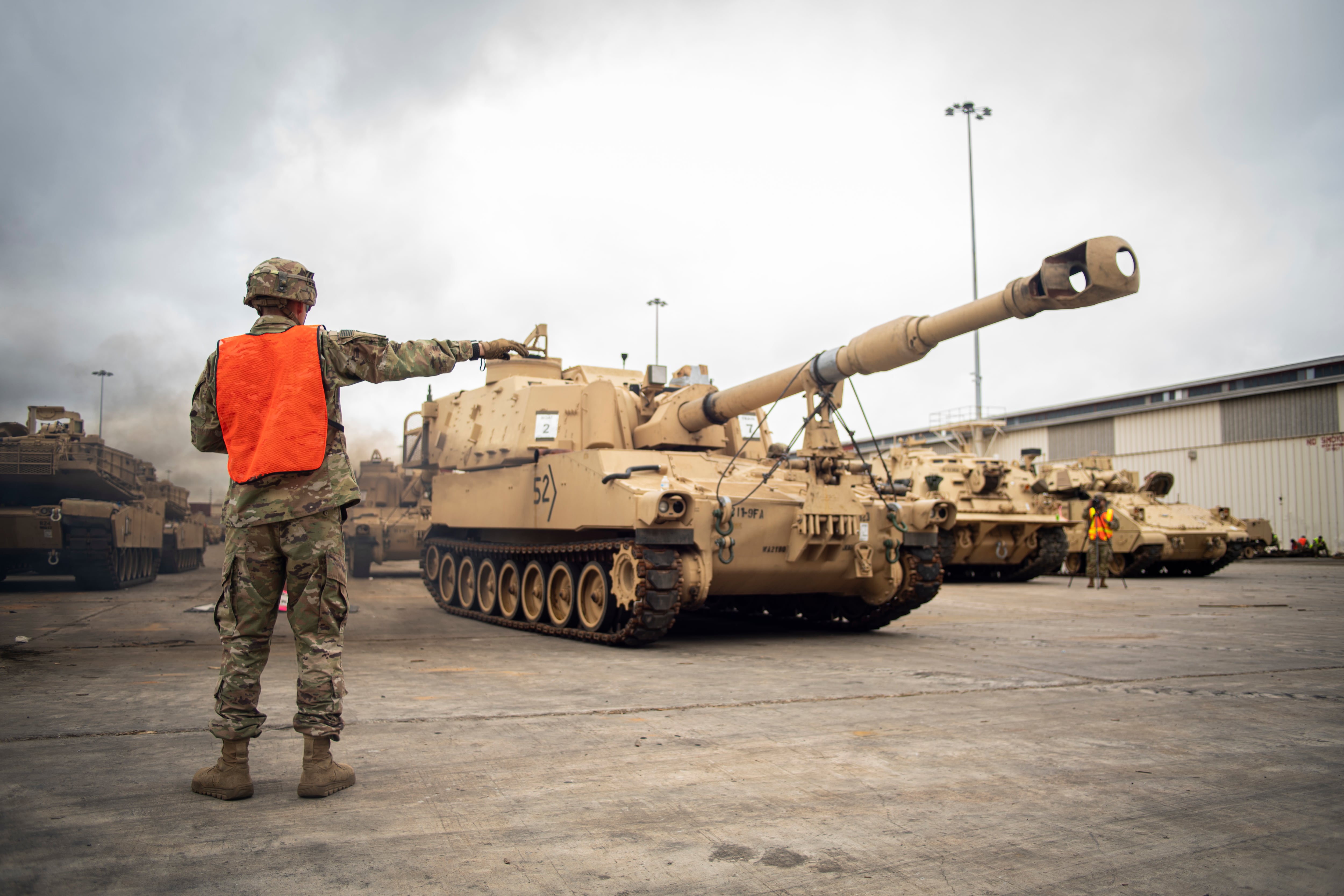CORRECTION — This story incorrectly spelled the name of an APS site in Powidz, Poland. V Corps will be based in Poznan, Poland.
WASHINGTON — The U.S. Army is taking steps to ensure its pre-positioned stock in the European and Asia-Pacific theaters is right-sized not just for conflict but for strategic competition with Russia and China, according to the service’s new commander in charge of materiel.
The service published a strategy for aligning its Army pre-positioned stock, or APS, a few years ago in order to modernize and configure the fleet for combat.
APS historically has been designed to be ready for troops to draw from rapidly to respond during a regional conflict. But since the strategy’s publication, the Army has realized “that we needed to take it to another level,” Gen. Edward Daly, Army Materiel Command chief, told Defense News in a November interview.
Daly assumed command in July after serving as the AMC deputy commander under Gen. Gus Perna. Perna is now in charge of the Trump administration’s Operation Warp Speed — an effort to rapidly develop a COVID-19 vaccine.
“We needed to relook [at] the purpose of Army pre-positioned stocks because, in the past, Army pre-positioned stocks were essential and key to great power conflict,” he said. “Now, based on the Army senior leaders’ intent, we want to focus it as much on great power competition, to use those stocks in great power competition as much as we had planned on using those stocks for great power conflict.”
This means the Army will exercise its APS more, according to Daly, and will also consider whether it must reset locations and composition of stock in theater. “I feel very, very comfortable. We’re on a good glide path in understanding what those requirements are” over the next five to 10 years, Daly said without going into detail. Certain details related to APS are classified.
The Army is also planning its budget to ensure APS is right-sized for the competition phase of operations in the upcoming five-year budget plan spanning from fiscal 2023 through fiscal 2027, Daly said.
On the European front, the Army is “taking an introspective look,” Daly said. “We know definitively some things we’re getting added to Europe. The second [armored brigade combat team] is an example, with some enablers in ... Powidz, Poland.”
The Army reactivated V Corps earlier this year, which will be based in Poznan, Poland, just an hour away from Powidz. V Corps will assume command and control of Atlantic Resolve rotational units as well as assigned units like the 2nd Cavalry Regiment, 12th Combat Aviation Brigade and the 41st Field Artillery Brigade, according to the newly combined U.S. Army Europe and Africa.
Defender Europe, a division-sized exercise that was supposed to kick off in full force in 2020, was dramatically scaled back due to the coronavirus pandemic. One of the goals of the exercise was to ensure the Army’s APS had the right equipment in the right places. But the European stock might require more tweaking as the Army measures it against what is needed to operate in a competition phase, according to Daly.
The Pacific stock will have a different flavor. The Army is working through a strategy there that requires a great deal of relationship-building with a bigger variety of countries in order to configure APS in the theater.
“We have, at AMC, as part of the Army guidance, focused on building and equipping new unit capabilities — the security force assistance brigades, the multidomain task force capabilities — and you layer in modernization efforts like long-range precision fires, etc. Now, inevitably, what you will get is a composition that potentially looks a little bit different than what it is today” when it comes to APS in the Pacific, Daly said.
As the strategy fleshes out in the theater, Daly said it’s likely APS won’t just be concentrated on the Korean Peninsula and Japan as it has been in the past.
“When you look at all the island chains and you look at how the Pacific is,” he said, “I think it’s safe to assume that there’ll be a little bit more geographical separation and probably more locations going forward than what we have now.”
Army Under Secretary James McPherson described the process of building out APS in the Pacific as a slow process because relationships with island nations must be developed over time.
“We don’t introduce ourselves to a potential partner or ally and say: ‘By the way, we’d like to put weapons platforms on your runway here.’ That’s not how it works,” he said in an interview with Defense News at the Association of the U.S. Army’s annual conference in October. “It’s much, much slower than that. We have a couple of, you know, lunch dates first and then maybe a dinner date, and we grow from there.”
While the Army has identified several countries with which it has good relations as potential locations, the relationship-building with other countries might involve inviting their students to the United States or offering to locally base humanitarian disaster relief supplies.
Beyond islands potentially hosting stock, the Army might also reconfigure its APS-3 Afloat, which is a fleet of giant, floating warehouses containing military equipment.
But the changes the Army is making will not require a new strategy, Daly said.
“I think it’s more of a refinement of the current strategy,” he explained. “I think we have less to do now because of the great work that obviously Gen. Perna and Army senior leaders did.”
Jen Judson is an award-winning journalist covering land warfare for Defense News. She has also worked for Politico and Inside Defense. She holds a Master of Science degree in journalism from Boston University and a Bachelor of Arts degree from Kenyon College.




